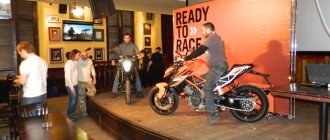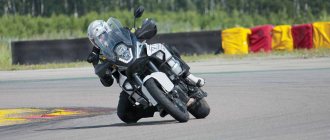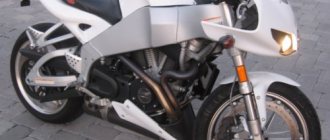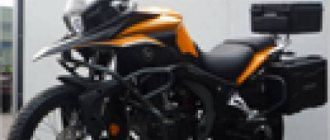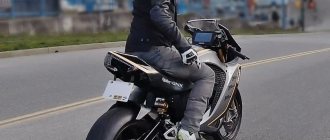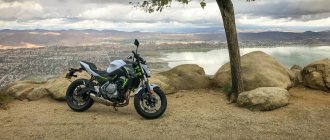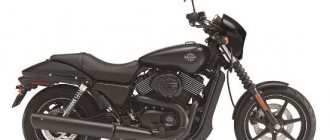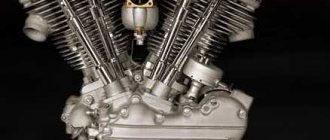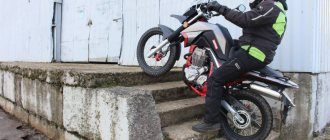From the editor:
“Help me decide on the choice of an inexpensive, but at the same time dynamic enough and convenient for daily use motorcycle” - we receive letters and questions on the forum with similar content with regular frequency. We offer you a comparative test of the two most popular naked bikes from Japan in Ukraine, conducted... by our readers! We hope that it will help you make your choice.
Andrey Bulanov
(Bandyno), 27 years old
Height: 187 cm, weight: 75 kg
Driving experience: 2 years
We meet by clothes.
The appearance of each of the tested corresponds to the class: “Bandit” is small, squat, a minimum of plastic, “clip-ons”, and... nothing superfluous. If you want to know what a “classic” should look like, look at Super Four, I won’t describe its appearance, because there are already hundreds of descriptions, they are all repeated, there is nothing new to add. The motorcycles' instruments are identical: identical in size, easy to read speedometer and tachometer, fuel gauges, turn indicators, neutral and oil pressure indicators. All. Everything you need and nothing extra.
I wasn’t very pleased with the view in the Suzukov mirrors; I had to hold my gaze a little longer than usual, and to be more confident, I also had to constantly turn my head. He would like a little more “mugs”, and some takeout. Although the problem here is not in the mirrors, but simply not for my height. Yes, the Suza, in general, by all indicators, is not a motorcycle for tall people. The SuperFour does things a little better in this regard, but also about a third of the area was occupied by the appearance of my shoulders. Although perhaps I'm being picky.
The subjects' seating position is class-appropriate: a slight forward lean, slightly set-back footpegs on the Suzuki, and an upright, almost touring riding position on the Honda. The “Bandit” seat is not conducive to long-term grips: the rider’s rear constantly slides forward, towards the tank. And if for the city this is, in general, not bad, since it makes it possible to clasp the tank with your knees and better feel the motorcycle, then for a long trip such a landing is inconvenient. But thanks to the well-thought-out shape of the tank, this motorcycle is comfortable to hold with your knees even for a tall driver, which cannot be said about the SuperFur: I was not able to comfortably wrap my knees around the sides of the motorcycle, despite the fact that in general the Honda driver’s seat is noticeably more comfortable than that of the Suzuki , and gives you the opportunity to position your “fifth point” in the way that is convenient for you. Things are no better with the passenger part of the Bandit's seat - it is very conditional and is only suitable for giving a short, slender girlfriend a ride to the nearest cafe. And on the contrary, the passenger seat of the “CiBiha” is more friendly to the “second number”: it is noticeably larger in area, the passenger footrests are not located so far back, and the landing as a whole is more direct, and therefore more comfortable.
Both motorcycles do not have wind protection, as a class, so if you plan to use them, including for long distances along the highway, you should think about buying a windshield (fortunately, finding the necessary one in the catalog is not a problem), because after 120 km /h begins to blow away so much that you have to cling tightly to the motorcycle, and on a long trip this is fraught with the onset of fatigue.
Both speedometers end at 180 km/h, and both motorcycles are capable of “setting the needle”, but for this, I at least needed to lie on the tank after 160 km/h in the case of the “Bandit” and after 170 -ty km/h - in the case of “Sibikha”. Firstly, so that I would not be blown away, and secondly, my windage did not allow the motorcycles to accelerate faster. I was very pleased with the dynamics of acceleration “to hundreds”, although no one measured the time, but both motorcycles are able to “shoot” up to this speed clearly faster than 4 seconds. If, during further acceleration, you keep the engine speed in the region of 10 thousand revolutions, then the dynamics of acceleration to “150” will not be much different.
Tell me who your friend is and I'll tell you
you... what kind of motorcycle does he need?
“Bandit” is a daring city hooligan and bully, there is no way you can ride him calmly: he won’t let you do it, because he is SO bored, he will provoke you, and, believe me, you WILL succumb to the provocation. Consciously or not, you will. Still would! “Short”, responsive throttle grip, instantly pushing the tachometer needle close to the “red zone”, growling sound of the engine, “short” gears. The engine starts to pull briskly from about 4 thousand, and pulls smoothly throughout the entire range, which makes it possible to accelerate equally and predictably in a wide range of revolutions without downshifting, and this is very convenient in city traffic. The motorcycle steers and corners beautifully. Thanks to its light weight, it will not be difficult to maneuver it between rows.
The CB400SF, even in the “S” version, is in some ways the opposite of the “Bandit”. Calm, soft, friendly, and generally just pleasant. It feels absolutely comfortable at low speeds, does not jerk, does not provoke, you drive along, admire the view of the city, the engine rumbles pleasantly... Yes, yes, it rumbles - unlike the aggressively growling “Bandit”. You don’t need to get used to it or get used to it: just sit down and go. However, despite all its complaisance, Honda will not allow itself to be offended; the characteristics of the engine are such that during intense acceleration the motorcycle simply “rips” from the bottom, allowing you to “punish” the impudent person (I think even someone like the “Bandit”) at the start from the traffic light. Further, after about 6-7 thousand revolutions, acceleration becomes smoother. Despite the good overall balance and balanced character of the motorcycle, it was annoying to note the fact that steering is a bit difficult: the classic straight handlebar is narrow, and, as a result, it is necessary to apply significantly more effort to shift the motorcycle into counter-steering.
The operation of components and assemblies on both motorcycles does not cause any complaints. The Susa gearbox works very softly, but not very clearly (I suspect that it is precisely due to excessive softness), so it is not always clear whether the gear has already engaged. Difficulties arose in finding neutral; the gearbox foot stubbornly slipped through this position. As for Honda... I heard a lot about the smooth operation of their gearbox, but somehow I never had a chance to drive one before testing. Well, what can I say about her... I'm amazed! I have never seen such a gearbox before. Soft, clear, quiet. Neutral is always and immediately - both from first and second gear.
The Suzuki suspension handles small and medium-sized irregularities well, confidently keeps the wheels tilted, however, it seems to me that it is not designed for a passenger weighing more than 50 kg. Honda's suspension behaves somewhat differently: the sports version has gas-oil, adjustable Showa ones installed at the rear, which are harsh even with the springs fully released for my weight (75 kg). Taking into account the fact that the motorcycle version is a sports version, it becomes clear why a stiffer rear suspension was installed there: it really holds the road better when inclined. But this only applies to smooth asphalt, and in the conditions of our roads, such a harsh suspension played a cruel joke on me: at the next turn, the rear wheel hit a bump, and my butt was kind of blown away. So I advise you to take this fact into account when choosing. But when driving with a passenger weighing about 80 kg, I was not afraid that the suspension would “break”, so you can carry larger girls.
The brakes on both bikes are commendable. Both have two disks in the front and one disk in the rear. (In this version of the Honda, Brembos are already stock in the front). When braking intensively with the front wheel, both motorcycles simply bite into the asphalt, and informative brake handles allow you to correctly dose the force, thereby promoting better control over the situation. Although, of course, it should be noted that Brembo is Brembo, and I liked the front brake of the “S” version a little more. When the rear brake is also connected during braking, the motorcycles do not just bite, but dig into the asphalt.
Summarizing everything written above, I would like to say that we have fallen into our hands two worthy representatives of their class - “city residents”. Each has its own character, characteristics, and manner of behavior, which I tried to reveal. Although you can’t tell everything right away, on the other hand, you won’t understand everything right away. Of these two devices, as a first motorcycle, I can recommend both, but with the caveat that in order to make friends with the “Bandit”, a person riding a motorcycle for the first time will need more time, patience, and accuracy. Whereas “SiBiha” will quickly become your friend, and will be more accepting of the mistakes of a person just starting his motorcycle journey.
When I was offered to conduct a comparative test of the Suzuki Bandit 400 and the Honda CB 400 Super Four in the “S” version, at first the purpose of such a comparison was not entirely clear to me, since in the first case we have “street”, and in the second we have “classic” . However, after it became clear that in this case we are dealing with a sports version of “CiBhi”, everything fell into place. So, we are testing urban “bullet guns”, the task of which is to teleport the owner from point A to point B in a minimum of time and with which they cope “excellently”. But first things first.
Yarema Mykhailiv, 27 years old
Height: 172 cm, weight: 60 kg
Driving experience: 2 years
When I first got on a motorcycle, I felt like “this is it, this is mine!” somehow it didn't appear. Well, yes, two wheels, four “pots”, a steering wheel, amazing dynamics and adrenaline. But something was missing. But the only small thing missing was to own your own such device, with all its advantages and disadvantages. And after purchasing my personal two-wheeled iron horse, the Suzuki Bandit 400V, after a while I had a question: “And, actually, how does it compare to competitors in its class?”
Therefore, I was glad to have the opportunity to participate in a comparative test of the Honda CB400 Super Four S and Suzuki Bandit 400V. Still, the motorcycles are very similar: both are naked classics, both city “badass” are street bikes, but this is only at first glance.
I get behind the wheel of the “Super Truck,” as the CB400SF is also called. The seating position is quite comfortable, vertical, the height of the saddle is quite suitable for my height. The steering wheel seems a little narrow for such a position, but in urban conditions its width can only be counted as a plus: the narrower it is, the easier it is to pass through the cracks among the “canned goods” in case of traffic jams. Ignition, turn signal, first gear - and we started driving around the city. The engine clearly responds to the throttle, increasing the speed, the transmission works very clearly. Second, third, fourth - the dynamics are quite on par. What’s noteworthy is that the traction reserve is enough to feel confident in traffic both at 3 thousand rpm and at 10 thousand - Honda engineers selected the gear ratios very well. But there is also a drawback: the dynamics are too smooth! Acceleration is stable at all speeds, without any noticeable pick-ups. The speedometer needle quickly moves to the number “160”, after which the air resistance begins to noticeably press on the chest, and the naked motorcycle, without fairings, begins to very slowly pick up speed, eventually resting against the edge of the speedometer scale. On the other hand, for driving around the city and for short country raids, this indicator is quite enough, even with your head. I lower the gear, flash the turn signal and begin to slow down before the turn. The front brakes are just a miracle! Of course: two four-piston calipers from the famous company Brembo (yes, Brembo comes stock on the “S” modification!) allow you to dynamically and effectively slow down and stop from almost any speed.
As for the suspension, on the “S” it is moderately stiff, which allows you to steer more accurately when cornering. It's about the fork. The rear Showa shock absorbers, as for me, are also designed for a passenger. Well, they don’t have enough softness on our native bumps and bumps in order to handle them comfortably! But with a passenger - that’s it, the suspension acquires the desired softness! Moreover, the wide passenger seat just begs to put your beloved girl on it and take it for a ride!
My partner and I exchange motorcycles, and now under me are 53 “horses” of the Suzuki Bandit, a born urban bully and provocateur. The seating position is more sporty, the steering clips are noticeably lower than those of the SuperFura. But the pot-bellied, wide tank allows you to hold the motorcycle quite effectively with your legs (by the way, I personally could not squeeze the Honda well with my knees - the tank is quite narrow). Bandit is good for not very tall drivers (which I am); Thanks to the low saddle and center of gravity, holding it is not a problem. But for those who are over 180 cm tall, it is no longer so comfortable: for my colleague with his height of 187 cm, when turning the steering wheel to extreme positions, the steering wheel handles rested on his knees. I take off, turn off the gas... and then the difference between these two motorcycles, so similar on the outside, becomes noticeable. The “Bandit” has less traction at the bottom; riding at 3-4 thousand is not for it. But connecting additional two valves per cylinder with the VC system at 8 thousand revolutions gives a noticeable pickup, which provokes you to unscrew the throttle even more. Active acceleration occurs in the same way as on the SV400SF, somewhere up to 160, after which the speed gain slows down, but the speedometer shows a slightly higher “maximum speed”. Naturally, such speeds are not nearly necessary for a city motorcycle (and are also illegal), but for long-distance runs for both the “SuperFura” and the “Bandit”, from personal experience I would recommend installing at least a small plastic shield attached to the headlight - very will help on long-distance trips!
The suspension is soft, very comfortable for a single rider, and the “Bandit” is largely designed for solo driving; the additional “ballast” behind the back immediately affects the load on the arms and affects the operation of the rear pendulum with a monoshock absorber. Personally, a couple of times, when I flew into a hole while driving with a passenger, I “punched” him. The control is precise, the motorcycle rolls and steers well in turns, one might even say it spins, clinging to the uneven asphalt with its rubber. Brakes? Even though it’s not Brembo, like the competitor’s, but the usual Tokiсo for the Japanese (also four-piston).
The appetite of both beauties is approximately the same: less than 6 liters on the highway, but in the city - it depends on driving style, and it can reach up to 9 liters.
Both motorcycles performed very well, the SuperFura is smoother, and the Bandit is a true reflection of its name, it is more aggressive and sharp. Both motorcycles are equally good in a modern metropolis thanks to their maneuverability and dynamics. But this does not prevent you from choosing any of them as your first motorcycle, or your second (when moving from a smaller capacity). And if you change consumables on time and take care of your pet, then it will delight you with its bass rumbling when you press the starter button for many months and years.
Motorcycles for testing were provided by the “to” salon
to.ua
